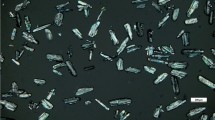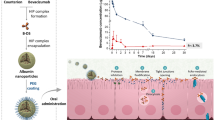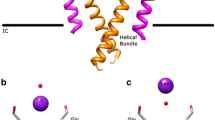Summary
In separated outer medullary collecting duct (MCD) cells, the time course of binding of the fluorescent stilbene anion exchange inhibitor, DBDS (4,4′-dibenzamido-2,2′-stilbene disulfonate), to the MCD cell analog of band 3, the red blood cell (rbc) anion exchange protein, can be measured by the stopped-flow method and the reaction time constant, τDBDS, can be used to report on the conformational state of the band 3 analog. In order to validate the method we have now shown that the ID50,DBDS,MCD (0.5±0.1 μm) for the H2-DIDS (4,4′-diisothiocyano-2,2′-dihydrostilbene disulfonate) inhibition of τDBDS is in agreement with the ID50,Cl −,MCD (0.94±0.07 μm) for H2-DIDS inhibition of MCD cell Cl− flux, thus relating τDBDS directly to anion exchange. The specific cardiac glycoside cation transport inhibitor, ouabain, not only modulates DBDS binding kinetics, but also increases the time constant for Cl− exchange by a factor of two, from τCl=0.30±0.02 sec to 0.56±0.06 sec (30mm NaHCO3). The ID50,DBDS,MCD for the ouabain effect on DBDS binding kinetics is 0.003±0.001 μm, so that binding is about an order of magnitude tighter than that for inhibition of rbc K+ flux (K I,K +,rbc=0.017 μm). These experiments indicate that the Na+,K−-ATPase, required to maintain cation gradients across the MCD cell membrane, is close enough to the band 3 analog that conformational information can be exchanged. Cytochalasin E (CE), which binds to the spectrin/actin complex in rbc and other cells, modulates DBDS binding kinetics with a physiological ID50,DBDS,MCD (0.076±0.005 μm); 2 μm CE also more than doubles the Cl− exchange time constant from 0.20±0.04 sec to 0.50±0.08 sec (30mm NaHCO3). These experiments indicate that conformational information can also be exchanged between the MCD cell band 3 analog and the MCD cell cytoskeleton.
Similar content being viewed by others
References
Allen, D.P., Low, P.S., Dola, A., Maisel, H. 1987. Band 3 and ankyrin homologues are present in eye lens: Evidence for all major erythrocyte membrane components in same non-erythroid cell.Biochem. Biophys. Res. Commun. 149:266–275
Ausiello, D.A., Hartwig, J., Brown, D. 1987. Membrane and microfilament organization and vasopressin action in transporting epithelia.In: Cell Calcium and the Control of Membrane Transport. Society of General Physiologists Series. Vol. 42, pp. 260–275. L.J. Mandel and D.C. Eaton, editors. Rockefeller University Press, New York
Barzilay, M., Ship, S., Cabantchik, Z.I. 1979. Anion transport in red blood cells.Membr. Biochem. 2:227–254
Bradford, M.M. 1976. A rapid and sensitive method for the quantitation of microgram quantities of proteins utilizing the principle of protein-dye binding.Anal. Biochem. 72:248–254
Brazy, P.C., Gunn, R.B. 1976. Furosemide inhibition of chloride transport in human red blood cells.J. Gen. Physiol. 68:583–599
Cabantchik, Z.I., Knauf, P.A., Rothstein, A. 1978. The anion transport system of the red blood cell: The role of membrane protein evaluated by the use of probes.Biochim. Biophys. Acta 515:239–302
Chen, P.-Y., Verkman, A.S. 1987. Renal basolateral membrane anion transporter characterized by a fluorescent disulfonic stilbene.J. Membrane Biol. 100:1–12
Cushman, S.W., Wardzala, L.J. 1980. Potential mechanism of insulin action on glucose transport in the isolated rat adipose cell.J. Biol. Chem. 255:4758–4762
Czerlinski, G.H. 1966. Chemical Relaxation, Chap. 3. Dekker, New York
Drenckhahn, D., Merte, C. 1987. Restriction of the human kidney band 3-like anion exchanger to specialized subdomains of the basolateral plasma membrane of intercalated cells.Eur. J. Cell. Biol. 45:107–115
Drenckhahn, D., Oelmann, M., Schaaf, P., Wagner, M., Wagner, S. 1987. Band 3 is the basolateral anion exchanger of dark epithelial cells of turtle urinary bladder.Am. J. Physiol. 252:C570-C574
Drenckhahn, D., Schluter, K., Allen, D.P., Bennett, V. 1985. Colocalization of band 3 with ankyrin and spectrin at the basal membrane of intercalated cells in the rat kidney.Nature (London) 230:1287–1289
Fossel, E.T., Solomon, A.K. 1978. Ouabain-sensitive interaction between human red cell membrane and glycolytic enzyme complex in cytosol.Biochim. Biophys. Acta 510:99–111
Fossel, E.T., Solomon, A.K. 1981. Relation between red cell membrane (Na++K+)-ATPase and band 3 protein.Biochim. Biophys. Acta 649:557–571
Illsley, N.P., Verkman, A.S. 1987. Membrane chloride transport measured using a chloride-sensitive fluorescent probe.Biochemistry 26:1215–1219
Janoshazi, A., Ojcius, D.M., Kone, B., Seifter, J.L., Solomon, A.K. 1988. Relation between the anion exchange protein in kidney medullary collecting duct cells and red cell band 3.J. Membrane Biol. 103:181–189
Janoshazi, A., Solomon, A.K. 1989. Interaction among anion, cation and glucose transport proteins in the human red cell.112:25–37
Knauf, P.A. 1979. Erythrocyte anion exchange and the band 3 protein: Transport kinetics and molecular structure.Curr. Top. Membr. Transp. 12:251–363
Kotaki, A., Naoi, M., Yagi, K. 1971. A diaminostilbene dye as a hydrophobic probe for proteins.Biochim. Biophys. Acta 229:547–556
Lin, D.C. 1981. Studies on human erythrocyte spectrin · 4.1 · actin complex with the use of cytochalasins.In: Erythrocyte Membranes 2: Recent Clinical and Experimental Advances. pp. 117–133. Alan R. Liss, New York
Lin, D.C., Lin, S. 1978. High affinity binding of [3H]-dihydrocytochalasin B to peripheral membrane proteins related to the control of cell shape in the human red cell.J. Biol. Chem. 253:1415–1419
Lukacovic, M.F., Verkman, A.S., Dix, J.A., Solomon, A.K. 1984. Specific interaction of the water transport inhibitor, pCMBS, with band 3 in red blood cell membranes.Biochim. Biophys. Acta 778:253–259
Nelson, W.J., Veshnock, P.J. 1987. Ankyrin binding to (Na++K+)ATPase and implications for the organization of membrane domains in polarized cells.Nature (London) 328:533–536
Proverbio, F., Hoffman, J.F. 1977. Membrane compartmentalized ATP and its preferential use by the Na,K-ATPase of human red cell ghosts.J. Gen. Physiol. 69:605–632
Salhany, J.M., Cordes, K.A., Gaines, E.D. 1980. Light-scattering measurements of hemoglobin binding to the erythrocyte membrane. Evidence for transmembrane effects related to the disulfonic stilbene binding to band 3.Biochemistry 19:1447–1454
Schuster, V.L., Bonsib, S.M., Jennings, M.L. 1986. Two types of collecting duct mitochondria-rich (intercalated) cells: lectin and band 3 cytochemistry.Am. J. Physiol. 251:C347-C355
Segel, I.H. 1975. Enzyme Kinetics. Wiley-Interscience, New York
Shaver, J.F., Stirling, C. 1978. Ouabain binding to renal tubules of the rabbit.J. Cell. Biol. 76:278–292
Solomon, A.K., Gill, T.J., III, Gold, G.L. 1956. The kinetics of cardiac glycoside inhibition of potassium transport in human erythrocytes.J. Gen. Physiol. 40:327–350
Stone, D.K., Seldin, D.W., Kokko, J.P., Jacobson, H.R. 1983. Anion dependence of rabbit medullary collecting duct acidification.J. Clin. Invest. 71:1505–1508
Verkman, A.S., Dix, J.A., Solomon, A.K. 1983. Anion transport inhibitor binding to band 3 in red blood cell membranes.J. Gen. Physiol. 81:421–449
Wagner, S., Vogel, R., Lietzke, R., Koob, R., Drenckhahn, D. 1987. Immunochemical characterization of a band 3-like anion exchanger in collecting duct of human kidney.Am. J. Physiol. 253:F213-F221
Wallick, E.T., Pitts, B.J.R., Lane, L.K., Schwartz, A. 1980. A kinetic comparison of cardiac glycoside interactions with Na+,K+-ATPases from skeletal and cardiac muscle and from kidney.Arch. Biochem. Biophys. 202:442–449
Zeidel, M.L., Seifter, J.L., Lear, S., Brenner, B.M., Silva, P. 1986a. Atrial peptides inhibit oxygen consumption in kidney medullary collecting duct cells.Am. J. Physiol. 251:F379-F383
Zeidel, M.L., Silva, P., Seifter, J.L. 1986b. Intracellular pH regulation and proton transport by rabbit renal medullary collecting duct cells: Role of plasma membrane H+-ATPase.J. Clin. Invest. 77:113–120
Zeidel, M.L., Silva, P., Seifter, J.L. 1986c. Intracellular pH regulation in rabbit renal medullary collecting duct cells: Role of chloride: bicarbonate exchange.J. Clin. Invest. 77:1682–1688
Author information
Authors and Affiliations
Rights and permissions
About this article
Cite this article
Janoshazi, A., Seifter, J.L. & Solomon, A.K. Interactions between anion exchange and other membrane proteins in rabbit kidney medullary collecting duct cells. J. Membrain Biol. 112, 39–49 (1989). https://doi.org/10.1007/BF01871162
Received:
Revised:
Issue Date:
DOI: https://doi.org/10.1007/BF01871162




